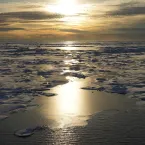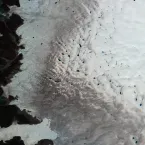Our Research
As climate changes, how do Earth's frozen areas affect our planet and impact society?
In this section
Related News & Stories
Filter by:

Spotlight
The NASA National Snow and Ice Data Center Distributed Active Archive Center (NSIDC DAAC) manages a range of MODIS data, making a suite of snow cover and sea ice data products freely accessible to the public. These data can be used to investigate how snow and ice cover have changed over time, to study Earth’s energy balance, and to feed global and polar climate models. Recently, the NSIDC DAAC published a new MODIS data set, MODIS/Terra Global Annual 0.01Deg CMG Snow Cover Climatology, Version 1. This data set focuses on global snow cover climatology from 2001 to 2023 using data from the Terra satellite and presents information using global maps.

Analysis - Sea Ice Today
The National Snow and Ice Data Center (NSIDC) has launched an upgraded and streamlined Sea Ice Today website. The new site replaces the Arctic Sea Ice News & Analysis (ASINA) website but continues the NASA-funded work on near-real-time assessments, daily data images, and monthly analyses on sea ice conditions that began in 2007.

Analysis - Sea Ice Today
Arctic sea ice continued the fast retreat that was observed in July through August 10, followed by a brief slowdown, only to pick up pace again. During the first half of August, the ice primarily retreated in the northern Beaufort Sea and in the East Siberian Sea.

Analysis - Ice Sheets Today
The 2024 melt season for the Greenland Ice Sheet is above the 1991 to 2020 average, but the total number of melt days and peak melt area for Greenland are within the midrange of the last 24 years.

Feature Story
From 2007 to 2022, renowned photographer James Balog documented glacial change around the world through a project called the Extreme Ice Survey. One and a half million images showcasing climate change in real time are now stored and managed at the National Snow and Ice Data Center.

Analysis - Sea Ice Today
Arctic sea ice cover retreated rapidly in July 2024, pushing the daily ice extent at the end of the month to the third lowest in the 46-year satellite record.